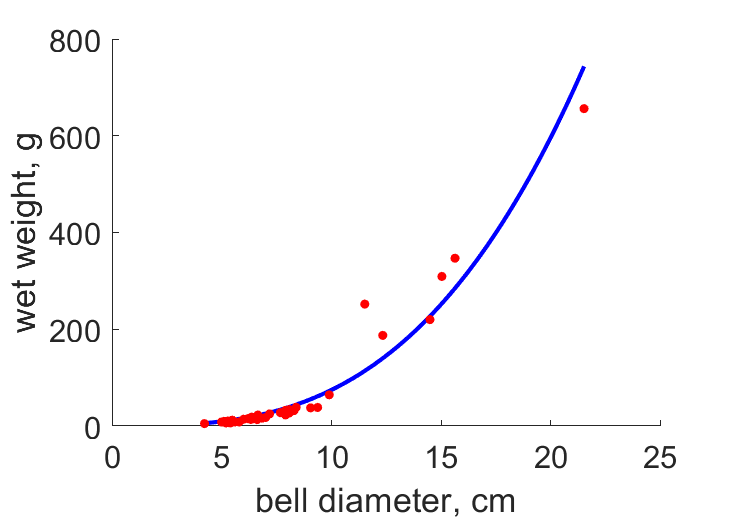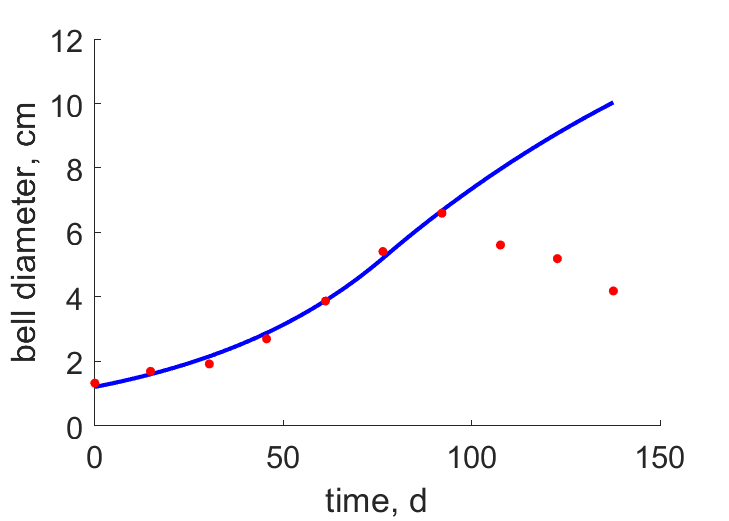Predictions & Data for this entry
| Model: abj | climate: MC, ME | migrate: | phylum: |
| COMPLETE = 2.5 | ecozone: MPN, MAN, MN | food: biCi, biCvf | class: |
| MRE = 0.052 | habitat: 0iMp, biMb | gender: D | order: |
| SMSE = 0.022 | embryo: Mp | reprod: Aa, Os | family: |
Zero-variate data
| Data | Observed | Predicted | (RE) | Unit | Description | Reference |
|---|---|---|---|---|---|---|
| ap | 43 | 45.07 | (0.04815) | d | age at puberty of the medusae | Brew1989 |
| am | 365 | 363.2 | (0.004931) | d | life span of the medusae | aquariumofpacific |
| Lb | 0.5 | 0.4687 | (0.06256) | cm | bell diameter at birth | flickr |
| Lp | 12.4 | 12.08 | (0.02546) | cm | bell diameter at puberty | Brew1989 |
| Li | 230 | 238.1 | (0.03503) | cm | ultimate bell diameter | Wiki |
| Ni | 1.5e+07 | 1.465e+07 | (0.02334) | # | cumulated # eggs | guess |
Uni- and bivariate data
| Data | Figure | Independent variable | Dependent variable | (RE) | Reference |
|---|---|---|---|---|---|
| LW |  | bell diameter | wet weight | (0.2266) | Brew1989 |
| tL |  | time | bell diameter | (0.03456) | Brew1989 |
Pseudo-data at Tref = 20°C
| Data | Generalised animal | Cyanea capillata | Unit | Description |
|---|---|---|---|---|
| v | 0.02 | 0.0577 | cm/d | energy conductance |
| p_M | 18 | 26.04 | J/d.cm^3 | vol-spec som maint |
| k_J | 0.002 | 0.002 | 1/d | maturity maint rate coefficient |
| k | 0.3 | 0.04009 | - | maintenance ratio |
| kap | 0.8 | 0.4 | - | allocation fraction to soma |
| kap_G | 0.8 | 0.8016 | - | growth efficiency |
| kap_R | 0.95 | 0.95 | - | reproduction efficiency |
Discussion
- This entry is about mudusae only; no mass of reproduction info available for the polyp stage
- Reproductive output is underestimated because ephyra is large relative to neonate planula
Facts
- eggs remain in the medusae till the 18 d of planula, which encyst before forming a polyp (planulocysts) (Ref: Brew1989)
- Feeds mainly on copepods during max growth (Ref: Brew1989)
- Polyp also produces cysts (stimulated by increase of temp) from which new polyps develop (podocysts); decrease of temp stimuates excystment ofpodocysts and the strobilation of polyps (Ref: BrewFein1991)
Acknowledgment
- The creation of this entry was supported by the Norwegian Science Council (NFR 255295)
Bibliography